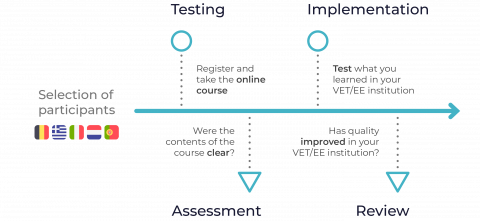4.4 - Three indicators to track learners’ achievements
Abstract
Individual learners’ achievements depend on a variety of factors: some of them are external, but
many relate directly to the quality of VET provision. The EQAVET framework offers three specific
indicators which can help you track learners’ achievements and use the data collected to improve the
overall quality of your VET provision.
Why is this important for you as a QM?
- To gain access to a wealth of valuable data which can be used to evaluate and improve the effectiveness of quality management within your institution;
- To demonstrate continued interest in the future of each learner, thus setting the ground for potential future collaboration.
How should I implement the action?
- Within its ‘toolbox’ of quality indicators, the EQAVET recommendation includes three interesting indicators that can help you track your learners’ achievements. Keeping track of the following data over the years can help you assess whether your courses meet the changing needs of your learners and of the labour market:
- Completion rate in VET programmes (EQAVET indicator n. 4): calculated as the number of persons having successfully completed/abandoned VET programmes, according to the type of programme and the individual criteria.
- Placement rate in VET programmes (EQAVET indicator n. 5):
- Keeping track of the destination of VET learners at a designated point in time after having completed their training, according to the type of programme and the individual criteria (for IVET, including information on the destination of learners who have dropped out);
- Calculated as the share of learners who have found employment at a designated point in time after having completed their training, according to the type of programme and the individual criteria.
- Utilisation of acquired skills at the workplace (EQAVET indicator n. 6):
- Collecting information on the occupation obtained by individuals after having completed their training, according to type of training and individual criteria;
- Keeping track of the satisfaction rate of new employees and employers with the skills and competences acquired by the former during training.
- Keep in mind that EQAVET was not designed as a prescriptive set of criteria, but rather as a ‘toolbox’ of indicators from which each Quality Manager is invited to select those that are more relevant to the requirements of their particular quality management system.
How should I know if I have made impact thus increasing the quality of the VET provision and to which extent? (Indicators also linked with the EQAVET if any):
- The EQAVET recommendation provides clear outcomes for each indicator. More specifically, successful tracking of learners’ achievements using the indicators listed above should allow the quality manager to:
- Indicator n. 4:
- Obtain basic information on educational achievements and the quality of the learning processes;
- Calculate drop-out rates compared to participation rates;
- Support successful completion as one of the main objectives for quality in VET;
- Support adapted training provision, including for disadvantaged groups.
- Indicator n. 5:
- Support employability;
- Improve responsiveness of VET to the changing demands of the labour market;
- Support adapted training provision, including for disadvantaged groups.
- Indicator n. 6:
- Increase employability;
- Improve responsiveness of VET to changing demands of the labour market;
- Support adapted training provision, including for disadvantaged groups.
- Indicator n. 4:
The tracking of learners’ achievements based on EQAVET indicators can be considered
successful if the quality of VET provision subsequently improves according to one or more of the outcomes foreseen for each indicator.For example, if learners’ satisfaction with the skills acquired during training and the
occupation they found afterwards are rigorously tracked, and if such information is fed into
the provider’s quality cycle for continuous improvement, the VET provider might be able to register an improvement in the employability of the following generations of learners. This
signifies that this action has been implemented successfully.
Links & further readings (includes also third-party resources- videos, etc.):
EQAVET recommendation (2009): https://www.eqavet.eu/Eqavet2017/media/Policy-Documents/Recommendation-on-the-establishment-of-European-Quality-Assurance-Reference-Framework-for-VET.pdf?ext=.pdf



